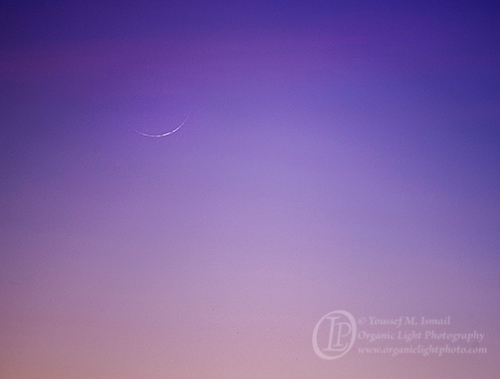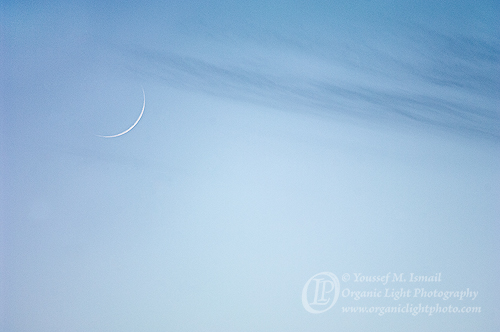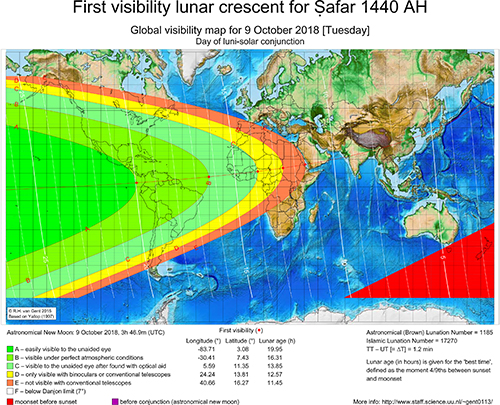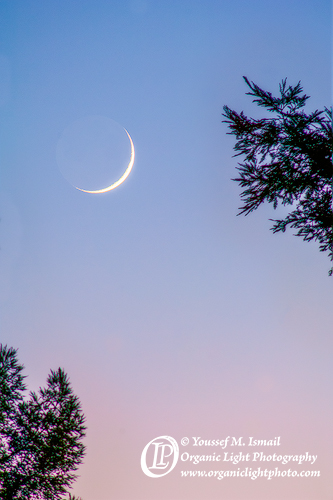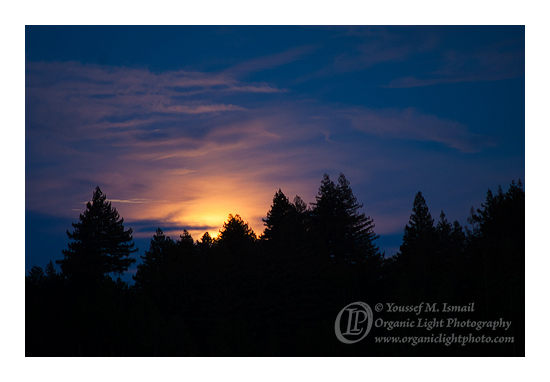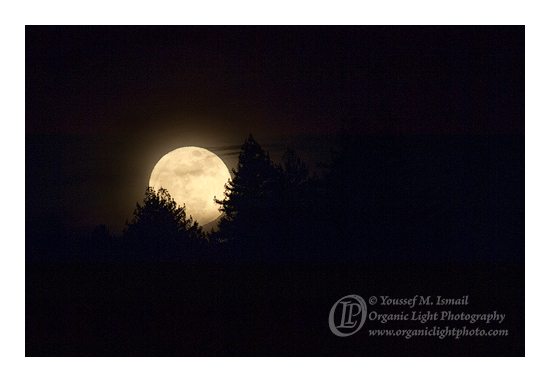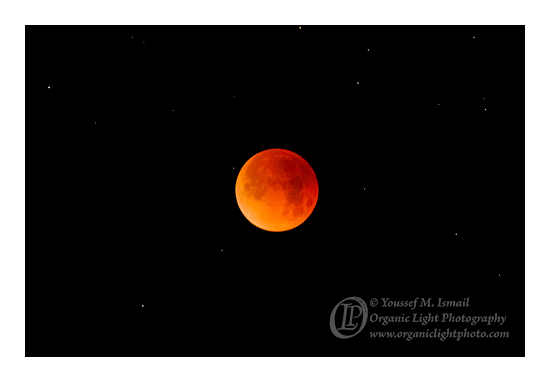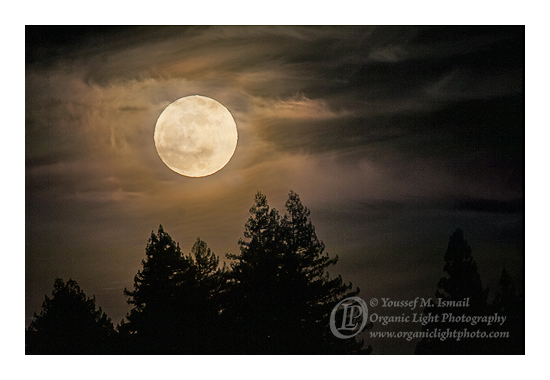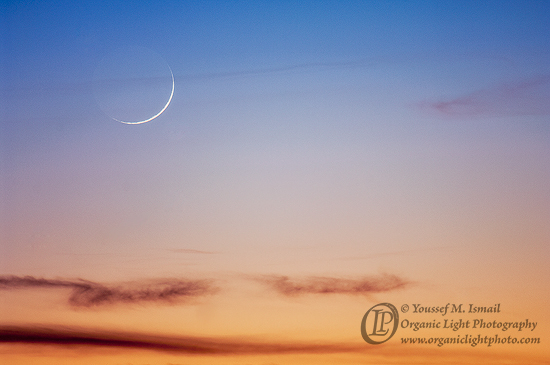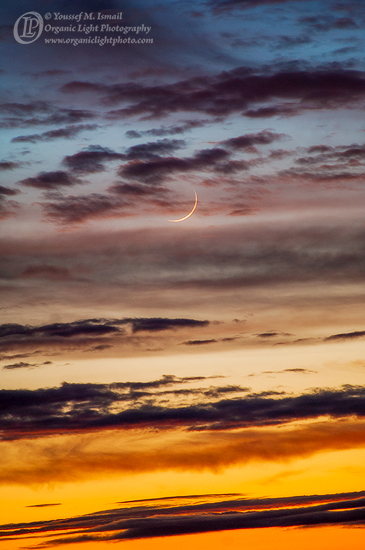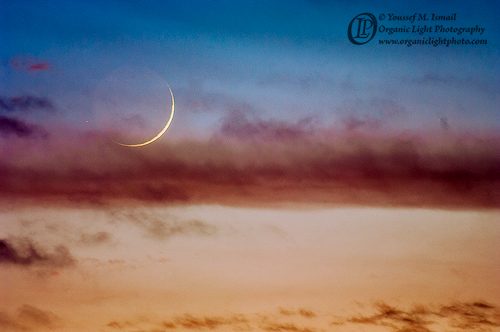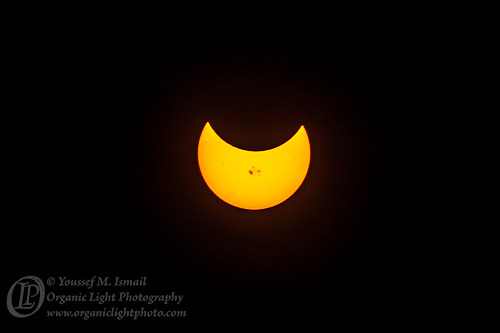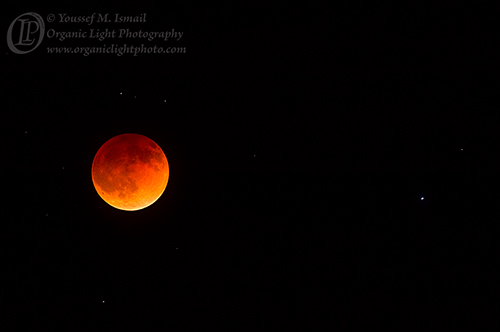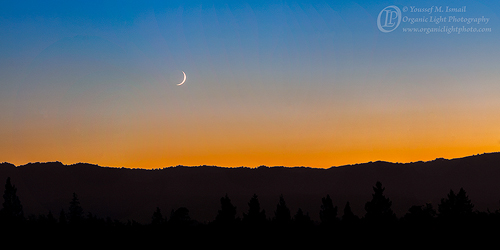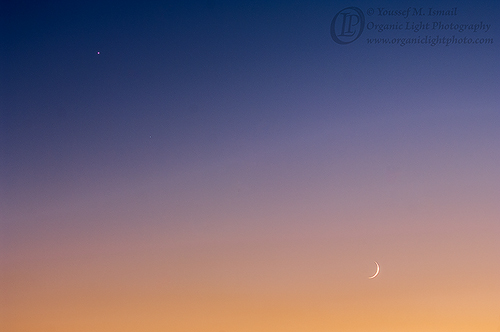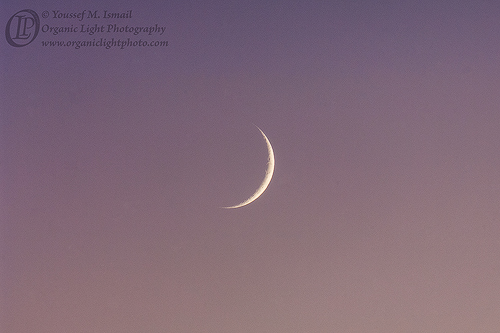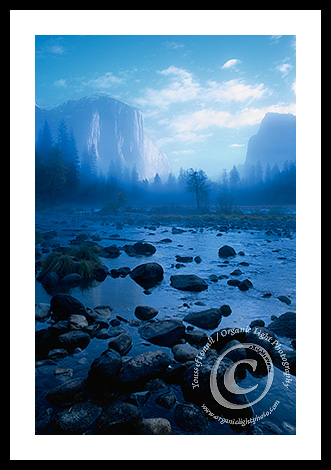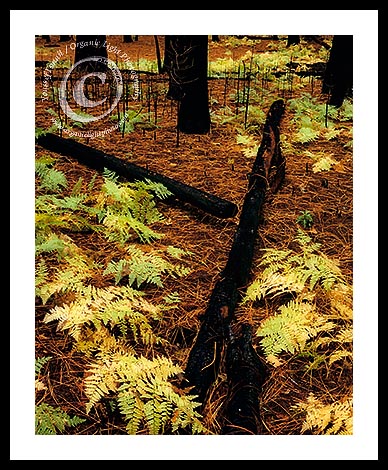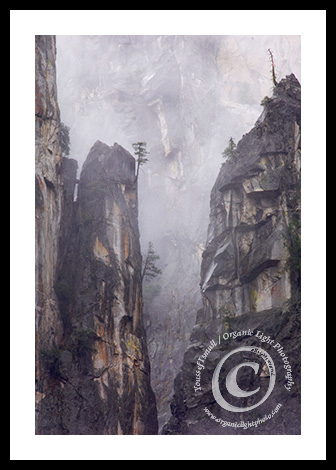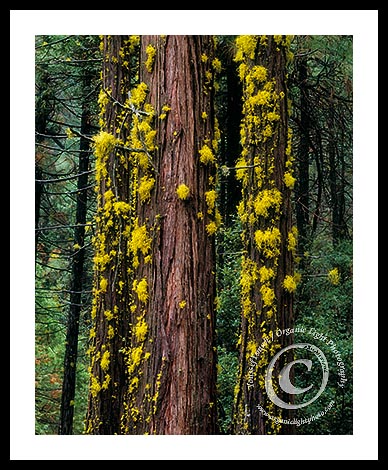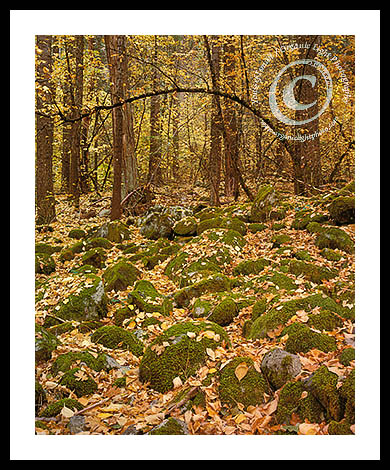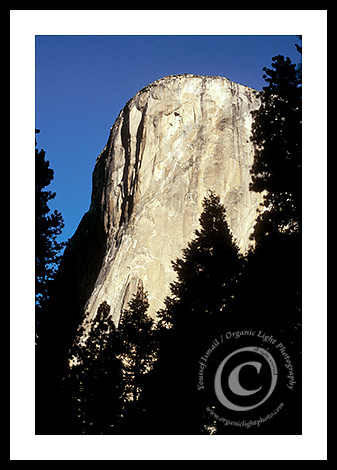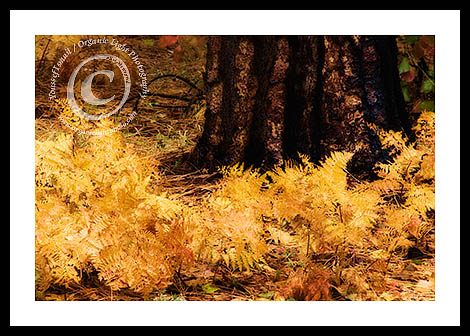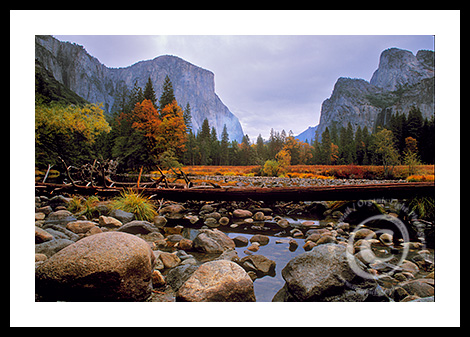Yesterday, July 16th, was the 29th day of Ramadan in the Islamic year 1436, or common era year of 2015. It was a day of great anticipation. Will we see the moon and end the fast or will it go on for another day? This Ramadan started without any contention at all! It was a refreshing respite from all the drama that is usually associated with the starts and stops of the Islamic months due to the confusion about seeing the new crescent moon. But as far as I could tell, the entire Muslim world began fasting on the same day! One week into the month, I started looking forward to the end of the month not to determine the if the moon would be seen or not, but to get a handle on if we would face a chaotic evening of chasing down errant reports all over the world. I researched two primary topics: crescent visibility probability curves and weather history.
The probability curves for July 16th are shown below. How they are generated is a topic on its own and is based on regression models and requires oodles of data from past sightings. The more data you have the more accurate the curves will predict the probability of seeing the new crescent. The curves are broken down into various regions shown by the different colors indicating how easy it will be to see the crescent. Zone A: easily visible to the unaided eye, Zone B: visible under perfect atmospheric conditions, Zone C: visible to the unaided eye after found with optical aide, Zone D: only visible with binoculars or conventional telescopes, Zone E: not visible with conventional telescopes, Zone F: below Danjon Limit (7°). Click on the image for a larger view.
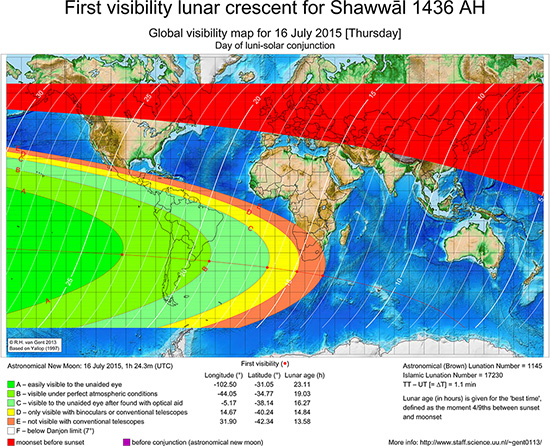
Sighting Curves for July 16th, 2015
Now before I go on let me qualify something. I started sighting the moon over 20 years ago. I have gone to look for it every month. I have seen many moons. The majority of those 20 years of sighting were made with no prior astronomical or probability prediction knowledge. I would always just based the sighting day 29 days later from the previous day I saw the moon. That is all one needs to know.
However over those years one gets to know what the moon looks like, where it will be in the sky in any given season, what orientation the moon will have and so on. Slowly as crescent moon sighting became more contentious I began to bolster my empirical knowledge with astronomical and probabilistic tools. I also started to teach astronomy, first at the elementary public school level and slowly moving up to higher levels until now at the college level. Now coupling both the 20 years of empirical knowledge and with some science it is not difficult to predict if the crescent will be seen, especially in one’s own locality.
So as I looked into where the moon might be seen yesterday what I noticed was that the best place on the planet was out in the South Pacific. Should not be a problem, no one lives on the water. However South America could have reports. In the last several years we have had some very strange and unverifiable reports coming from the south especially from Chile. But most of South America was in the Zone B, and given perfect atmospheric conditions – meaning the skies needed to be totally clear we very well could receive reports from there. So I looked into the weather history of the region in Chile where we have some contacts that have given us reports in the past.
In the month of July South America is in the midst of winter and in Chile 67% of the month of July is under cloudy and overcast skies. I did not think a report from Chile would come in this year. However, yesterday evening, Chile had clear skies! The interesting result is that Chile had a negative sighting as well as all of South America, except for one report coming out of Bogota, Columbia, and that sighting was with a high-powered telescope.
Why is that important? For one it was made with a telescope and that does not constitute a valid sighting according to Islamic Law. Second it was a high-powered telescope. Why? If you look at the lunar age of the moon in the best location in Zone A it is only 23.11 hours past conjunction. And in Zone B, where the telescope sighting was made it was only 19.03 hours old past conjunction. Conjunction is the instant of the birth of the new moon.
A 23 hour old moon is very difficult to see by the unaided eye, if at all. Here is just such a moon from ten years ago. The Islamic month was Rajab, and it took place on August 5th, 2005, almost ten years ago to the month. Click on the image to see it in full.
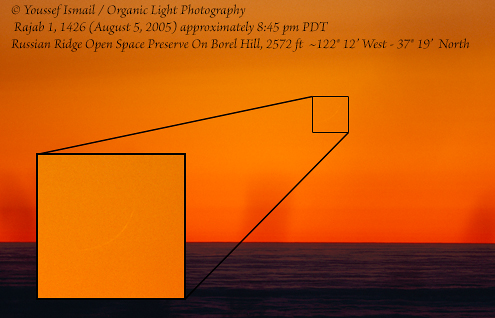
A 23.5 hour old moon
Last night, the contentions for the sightings did not come from where we expected them, South America. They cropped up from my own backyard here in the San Francisco Bay Area and a couple other places in California. In California, the age of the moon was roughly 24.8 hours old. Not much older than the moon shown in the photo above. In San Diego, it was 24.35 hours old. In San Francisco, 24.88 hours old. In the middle of the state 24.82 hours old. This time of the year, the orientation of the crescent is as shown in the photo. The limbs should run from about 2:00 to about 7:00 o’Clock on the clock dial. This orientation of the moon’s limbs changes through the seasons. In the summer and winter it is oriented as shown in the photo, with some slight variations, while in the spring the lit portion is on the bottom and the limbs point upwards and in autumn a bit more steeper running from 1 o’Clock to about 6 o’Clock. This is important as we will see below, so keep this in mind.
The sighting curves are based on five parameters that need to be met in order for the moon to be seen easily by the unaided eye. Those parameters are, age of the moon beyond conjunction, the time between sunset and moonset (known as the lag time), the elongation (a geometric orientation of the Earth, Moon and Sun past conjunction), the % illumination of the moon and the altitude of the moon at sunset above the horizon. The criteria for sighting a moon with the unaided eye are as follows:
Age: 18 hours
Lag time: 40 minutes
Elongation: 12°
% Illumination: 1%
Altitude: 5°
Let me further qualify what these values indicate. Neither one is more important than another. The probability of the moon’s visibility cannot be determined by just one or two of these parameters. Each parameter needs to be met. The values given here are the absolute minimum values that are needed for the moon to be seen by the unaided eye. Now just because the age of the moon is greater than the minimum 18 hours will not alone make it visible, especially if for example the lag time is less than the 40 minutes. Likewise, if the moon’s age was, for example, 28 hours old, but the lag time was say 15 minutes or that altitude was only 2°, the moon will still not be seen by the unaided eye, or it will be very difficult at best.
The conditions for the moon shown above from 10 years ago were:
Age: 23.5 hours
Lag time: 46 minutes
Elongation: 11°
% Illumination: 1%
Altitude: 8.1°
With 4 out of the 5 criteria met, and the 5th, elongation, very close, I still could not see this moon with my unaided eyes. How then did I get this photo you ask? I had a general idea of where the moon should have been in the sky and I pointed my camera lens in that area and tripped the shutter. I actually made several photos panning the sky making sure I had sufficient overlap. I was amazingly surprised to have caught the moon in the photo!
Yesterday in the SF Bay Area, in the same location as where the Rajab photo of 2005 was made, the moon had the following conditions:
Age: 24.85 hours
Lag time: 20 minutes
Elongation: 13.3°
% Illumination: 1.3%
Altitude: 3°
Yesterday’s moon only meets 3 out of the 5 criteria. The above pictured moon met 4 out of 5 and was still not visible with the unaided eye. I am not sure how yesterday’s moon was seen. In the areas where the moon was claimed to have been seen, the same 3 out of 5 criteria as well were met.
Here is the interesting result. In Chile, where it could have been seen, the criteria were:
Age: 20 hours
Lag time: 46 minutes
Elongation: 11°
% Illumination: 0.9%
Altitude: 9°
3 of the 5 criteria were met and the other two were very close to meeting the limits, and yet it was not seen!
What is more concerning is that the majority of the reports that we obtained by speaking directly to the claimants, did not describe the moon as the moon seen above in the photo of what a moon of this season and timing should look like. One description given was a line that was flatter, oriented more towards the bottom with limbs more like 4 o’Clock to 7 o’Clock. Two of the reports said that what they saw suddenly became very bright and shiny when they saw it.
All the of the claimants giving reports mentioned that they saw it very shortly after the sun set, within 2 to 7 minutes after sunset. One of the claimants, reported that what he and his group saw appeared before the sun set. Before sun set!
The first question that needs to be asked is does a person engaged in sighting the moon need to versed in astronomy and in particular the details related to the moon? The answer is no. I did not have that knowledge when I first started looking for the moon, but with experience these particulars become second nature. Having knowledge about what the moon looks like in the sky, where in the sky it will appear, and its orientation will serve the seeker in not making erroneous sightings. Any person can become a skilled moonsighter whether they are an upright Muslim or not. The character of an upright Muslim is not a shield that prevents erroneous sightings from being made. At the same time an erroneous sighting made by an upright Muslim does not in any way imply anything about the person’s character. Inexperience and ignorance of the details about the nature of the moon is what brings about the erroneous reports but does not put the person’s character in question.
Moving on, the optimal time of crescent visibility on the evening of a new moon occurs when the the contrast between the moon and the evening sky reaches its maximum. Two things need to happen for this maximum contrast to occur. First, the sky needs to darken and at the same time as the sky darkens, the moon starts to brighten. Maximum contrast takes place at 4/9ths of the lag time. That is, the lag time is taken and divided into 9 parts. Then adding 4 of those parts will indicate when the best viewing time occurs. Last night here in California, with lag times of 20 minutes, 4/9ths amounts to 8 minutes and 53 seconds after sunset. And for an easily seen moon, with a lag time of 40 minutes this amounts to 17 minutes and 45 seconds. So, one would need almost 18 minutes for the moon to reach the optimal contrast in the sky for a moon that is easily seen by the unaided eye. Last night, the moon only had a lag time just slightly longer than the optimal time. Far from ideal. At 2 to 7 minutes after sunset, the sky would be so bright and the crescent so dim, that it is nearly invisible at that time. And before sunset, if the sun itself does not blind the eyes, its brightness will certainly limit anything you can see in the sky near the sun.
We live in a time in which our skies are filled with many flying objects. Objects that did not exist at the time of the Prophet Muhammad, peace be upon him, and not for more than 1000 years after His time. Those flying objects leave many traces in the sky that can easily be misconstrued as the crescent moon to the inexperienced and unskilled seeker of the moon. Here is a link to a small gallery of photos of just such traces that can easily be mistaken for the moon. And in fact, many times when interviewing claimants, these are the exact items that they describe to us. Here is the link
I do not know what those claimants saw on Thursday evening. I am not accusing anyone of anything. They saw what they saw and they reported it as such. They were honest and sincere, and may they be rewarded accordingly by our Creator.
What concerned me in this whole affair is why were their reports not examined with more scrutiny by those who were charged with making a decision about breaking the fast? There were more details involved than I have mentioned that needed to be addressed. I and another friend working with me did. Before we even had spoken to half those claimants who had a report, the decision to break the fast, based simply on that those reports were made, had already been made by most mosques and organizations. Confusion was rampant all night long.
So what happened last night? I am not entirely sure. I was content and certain the moon had not been seen. My Ramadan did not end last night. I was not even going to voice my concerns as over the years I have learned this only stirs the drama pot and makes things worse. That was until I saw this…

A Minion Eid
This is, in a sad and hilarious way, what I feel is happening. My pressing question though is, the Minions of Who? Minions of the One Eye, the Nafs…Who?
Later tonight I will be heading out once more to seek out the new moon. I will of course be photographing it and it will, insha Allah (God willing) be posted here on Organic Light Pan.
I wish everyone, and I mean everyone, a most Blessed Eid, filled with love, laughter, family, friends and joy, and may you receive all the rewards of fasting the month of Ramadan. May our Creator forgive us all for our mistakes and trespasses and bring our hearts together in love and brotherhood and sisterhood.
To all, Eid Mubarak and Peace!
